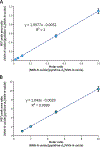Mass Spectrometric Quantitation of N'-Nitrosonornicotine-1 N-oxide in the Urine of Cigarette Smokers and Smokeless Tobacco Users
- PMID: 36006857
- PMCID: PMC9608542
- DOI: 10.1021/acs.chemrestox.2c00195
Mass Spectrometric Quantitation of N'-Nitrosonornicotine-1 N-oxide in the Urine of Cigarette Smokers and Smokeless Tobacco Users
Abstract
N'-Nitrosonornicotine (NNN) and 4-(methylnitrosamino)-1-(3-pyridyl)-1-butanone (NNK), which always occur together and are present exclusively in tobacco products, are classified as "carcinogenic to humans" (Group 1) by the International Agency for Research on Cancer. While 4-(methylnitrosamino)-1-(3-pyridyl)-1-butanol (NNAL) serves as an excellent biomarker for NNK exposure, the currently available biomarker for NNN exposure is urinary "total NNN" (free NNN plus its N-glucuronide). Quantitation of urinary NNN requires extensive precautions to prevent artifactual formation of NNN resulting from nitrosation of nornicotine during analysis. NNN itself can also be formed endogenously by the same nitrosation reaction, which may sometimes cause an overestimation of exposure to preformed NNN. It is thus important to develop an alternative biomarker to specifically reflect NNN metabolic fate and facilitate relevant cancer etiology studies. In this study, we report the first detection of N'-nitrosonornicotine-1N-oxide (NNN-N-oxide) in human urine. Using a highly specific and sensitive MS3 transition-based method, NNN-N-oxide was quantified with a mean level of 8.40 ± 6.04 fmol/mL in the urine of 10 out of 32 cigarette smokers. It occurred in a substantially higher level in the urine of 13 out of 14 smokeless tobacco users, amounting to a mean concentration of 85.2 ± 96.3 fmol/mL urine. No NNN-N-oxide was detected in any of the nonsmoker urine samples analyzed (n = 20). The possible artifactual formation of NNN-N-oxide during sample preparation steps was excluded by experiments using added ammonium sulfamate. The low levels of NNN-N-oxide in the urine of tobacco users indicate that the pyridine N-oxidation pathway represents a minor detoxification pathway of NNN, which further supports the importance of the α-hydroxylation pathway of NNN metabolic activation in humans.
Conflict of interest statement
The authors declare no competing financial interest.
Figures




Similar articles
-
Exposure and Metabolic Activation Biomarkers of Carcinogenic Tobacco-Specific Nitrosamines.Acc Chem Res. 2016 Jan 19;49(1):106-14. doi: 10.1021/acs.accounts.5b00472. Epub 2015 Dec 17. Acc Chem Res. 2016. PMID: 26678241 Free PMC article.
-
Combined analysis of N'-nitrosonornicotine and 4-(methylnitrosamino)-1-(3-pyridyl)-1-butanol in the urine of cigarette smokers and e-cigarette users.J Chromatogr B Analyt Technol Biomed Life Sci. 2015 Dec 15;1007:121-6. doi: 10.1016/j.jchromb.2015.10.012. Epub 2015 Oct 31. J Chromatogr B Analyt Technol Biomed Life Sci. 2015. PMID: 26595795 Free PMC article.
-
Tobacco-specific nitrosamines and their pyridine-N-glucuronides in the urine of smokers and smokeless tobacco users.Cancer Epidemiol Biomarkers Prev. 2005 Apr;14(4):885-91. doi: 10.1158/1055-9965.EPI-04-0753. Cancer Epidemiol Biomarkers Prev. 2005. PMID: 15824160
-
An update on the formation in tobacco, toxicity and carcinogenicity of N'-nitrosonornicotine and 4-(methylnitrosamino)-1-(3-pyridyl)-1-butanone.Carcinogenesis. 2024 May 19;45(5):275-287. doi: 10.1093/carcin/bgae018. Carcinogenesis. 2024. PMID: 38437625 Free PMC article. Review.
-
Tobacco-specific N-nitrosamines and Areca-derived N-nitrosamines: chemistry, biochemistry, carcinogenicity, and relevance to humans.J Toxicol Environ Health. 1994 Jan;41(1):1-52. doi: 10.1080/15287399409531825. J Toxicol Environ Health. 1994. PMID: 8277523 Review.
Cited by
-
Mass Spectrometry-Based Metabolic Profiling of Urinary Metabolites of N'-Nitrosonornicotine (NNN) in the Rat.Chem Res Toxicol. 2023 May 15;36(5):769-781. doi: 10.1021/acs.chemrestox.3c00025. Epub 2023 Apr 5. Chem Res Toxicol. 2023. PMID: 37017527 Free PMC article.
References
-
- Hecht SS Biochemistry, biology, and carcinogenicity of tobacco-specific N-nitrosamines. Chem. Res. Toxicol. 1998, 11, 559–603. - PubMed
Publication types
MeSH terms
Substances
Grants and funding
LinkOut - more resources
Full Text Sources
Medical

